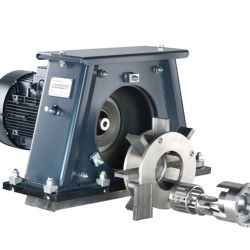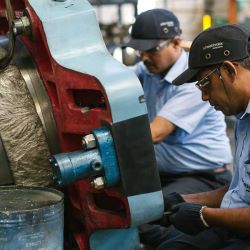Scott Dabbs is the new application technology manager of the Wheelabrator Customer Application Lab in LaGrange, Georgia. Having joined the company in 2012, his background in assembly, field repairs, installation and electrical engineering leaves him with vast experience of fine tuning shot blast machines. Here we speak to him about the Customer Application Lab, what it does for customers and the benefits of visiting the facility.
What is the purpose of the Customer Application Lab?
Wheelabrator’s Customer Application Lab is 100% for the customers. It is configured to help us solve their problems in a process and environment that’s as collaborative as it possibly can be.
No one knows their current blast challenges like the customer, we understand that, and we value their opinions, so the aim is to bring their knowledge together with our shot blast and testing expertise to make their processes better, get their parts through faster and save them money.
What are the benefits a customer will get out of visiting the lab?
One of the best things about coming to our lab in LaGrange, is that through a combination of machine selection, validation testing and refinement – we create a machine that is proven to exactly match a customer’s needs. Think of it as made to measure machinery.
Right now, on the lab floor, we have seven machines which can be prepped and ready to run customer parts within a days’ notice. We run the customer’s actual parts, which they send ahead to us.
By the time they get to LaGrange for the demo, we can focus on giving them a real understanding of why a certain machine will meet their needs, how we size it for them – and at the same time we figure out the media type, shot size, cycle time, and the velocity that we need to throw it at to achieve the desired finish of the parts.
When customers come in, it greatly reduces the chances of any problems occurring further along in the process when they receive their machine, as we’ve already validated the recipe. So there should be no question whether it will work, which in the end reduces running costs and downtime.
Another great benefit to customers is that they get to meet the engineering team and we take them to speak to the application specialists – that’s where you start deepening your relationship, not over the phone and not on email.
What kind of things do you help with? Do you have any examples of common mistakes and pitfalls?
A common problem we see is customers using abrasive that’s way too big. We had a customer a while back that was using the biggest shot they could find. When we started running some parts for them, we tried around five different shot sizes on the parts – eventually dropping the abrasive size by almost four times what they were using.
Previously they were only throwing roughly 30,000 BBs (or steel shots) per pound – when we were done they were getting more than half a million BBs per pound. By hitting the part many more times per second, they get the same coverage but with a much faster line speed.
Another important thing we can assist customers with here in the lab is designing and developing fixtures for their parts to ensure the best blast coverage – it’s one thing configuring the machine, but it’s another knowing how to fix the parts in place, so you hit all angles without shadowing or masking, to achieve the very best abrasive coverage for cleaning the parts.
Blast machines don’t come with fixturing as standard, so most companies that buy a machine come up with their own types of fixture.
During the customer’s visit to the Application Lab, Khai Nguygen our in-house Application Technician can design a tested fixture specifically for the customer’s process – right here in the lab, so the customer can see it immediately.
Another area we generate big gains is replacing older blast wheels with new ones that throw shot at a high velocity – this works particularly well for customers whose objective is to clean parts. By throwing the media at a higher velocity, we can possibly drop down a couple of shot sizes and still have the same impact energy as before.
When you drop abrasive size you automatically start saving money. The smaller the abrasive the slower the abrasive breaks down. This also increases coverage which directly relates to possibly speeding up production.
Moving the processing of certain smaller parts from tumblast to barrel blasting has been another huge success for customers. Sometimes, depending on their shape, parts can get trapped in the flights of a tumblast machine where they’re crushed or even broken. Our experience combined with testing will ensure customers are using the right machine for the right parts.
When added to the picture of all of the other testing and refinement we do here – the customer reliably achieves an outcome that precisely matches their specific application.
What are the major features of the lab? What equipment do you have on site?
The Customer Application Lab is a 10,000 square foot facility. If we have a customer that needs to have a specialized process created quickly, we can do that in a day’s notice thanks to the wide range of machines on site.
The variety of machines we have on site include mesh belt, tumblast, barrel, table, carousel, and we have two spinner hangers. We also have another machine that simulates a variety of applications and replicates the performance of a lot of different kinds of blast machines.
How quickly can customers get you to demo something for them? Is there a wait?
In most cases, we can schedule a demo for customers within a week, two weeks max. Our machines are prepped and ready to run customer parts within a days’ notice, but the lab does get busy and we need time to plan in the work.
The whole process begins when we actually receive the parts. We’ll then book a slot for the testing and work on the parts for two solid days before the customer arrives.
This is important as it saves time when customers come in. It means we can have the parts ready for them to inspect with different surface profiles and finishes so they can immediately let us know which one they like. We can then set the machine up specifically for that test. This allows us to use the time they’re here to optimize and refine.
Is it essential to come along, or can customers just send in their parts?
To make it as simple as possible and to help those located further afield, customers can either come along and visit us at the lab or send their parts into us for testing.
If a customer sends their parts to us, we ask a few basic details such as how many parts they need per hour, what type profile they want to achieve, and whether the process is general cleaning, coating or peening. Then we’ll do some testing, figure out the correct media for the surface profile and design a fixture optimized for their parts.
After we’ve run our tests, the parts go back to the customer for quality inspection along with a detailed report that includes pictures and documentation covering the whole testing process. The report breaks down exactly what they need to optimize their processes.
As convenient as that service is however, there’s nothing quite like seeing something first hand for yourself. Getting customers to come and see us optimizing their processes is important. It enables us to more responsively engineer tweaks with their input and adjust variables live in the facility.
A lot of great things happen here when the customer comes to the lab.
Finally, what do you see as the big opportunity for the Customer Application Lab?
Our Equipment Modernization Program (EMP) is another area of expertise at Wheelabrator, and I see this as an important opportunity for the team here at the lab to further assist customers achieve greater productivity.
A lot of customers have machines already. Many have had them for up to 30 years, but an EMP has the potential to transform its performance and bring it as close to new as possible.
With an EMP, customers can keep the same machine and blast their parts faster and better. From our side, customers can come in and see the new design concepts and parts such as wheels, abrasive control valves and other enhancements that really bring their machine up to speed. Once we’ve decided on the nature of refinements, we can then conduct the EMP on their machine in the field.
Finally, and more broadly, I think the biggest customer benefit has to be the technical expertise acquired in lab through collaboration between our application specialists and the customer.
There’s nothing quite like having a process custom built around your needs and having input into the process yourself. Getting customers to come and experience the latest shot blast technology is a huge opportunity – for them and for us.
We don’t charge anything to run a test which makes it easy for customers to challenge their current set-up and keep optimizing. In my opinion, this process delivers extremely valuable information to any company using shot blast equipment. If nothing else, it’s good to have an up-to-date review of your process, but beyond that – the refinements we recommend are highly likely to save money.
And who could say no to that!
To get in touch with Scott and book an appointment at the Wheelabrator Customer Application Lab, please email Scott.


